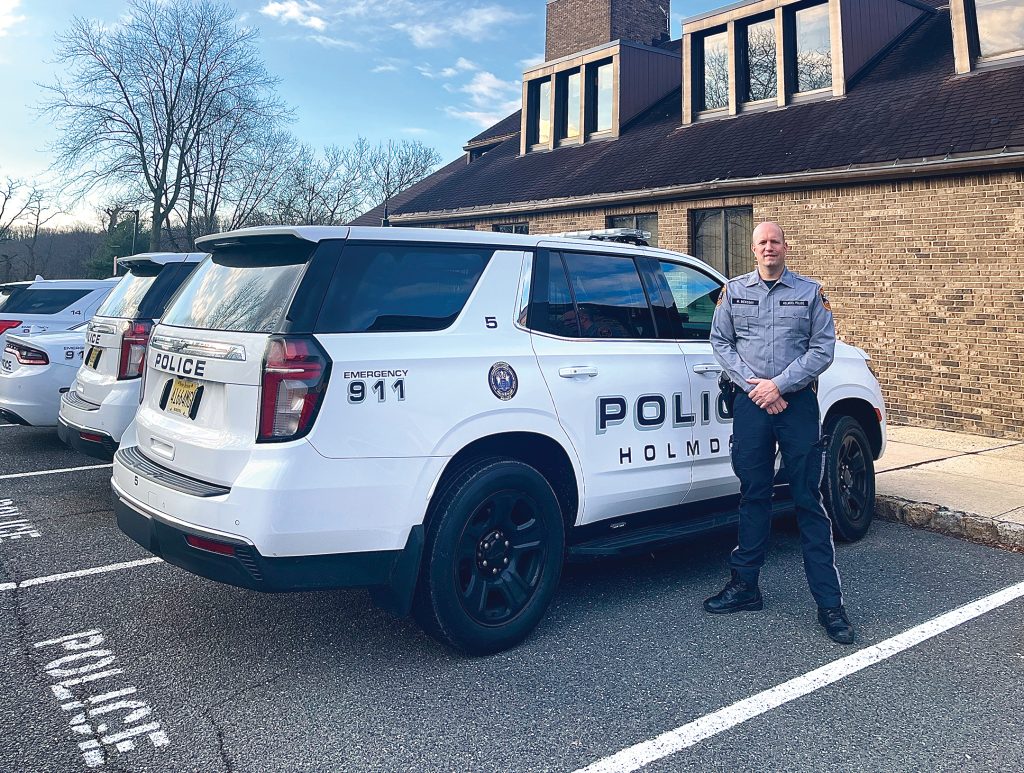
By Sunayana Prabhu
HOLMDEL – Patrolman Matthew Menosky has a clear vision for the roads: “Zero deaths, zero injuries, zero crashes.”
Goal:Zero, the grassroots campaign started by Menosky in Holmdel Township has now expanded and is being implemented in six towns in Monmouth County. The campaign to reduce deadly motor fatalities is being used on the stretch of Route 34 from Matawan through Wall.
Goal:Zero, which kicked off Feb. 21, will stay in effect between 3 and 7 p.m. Officers from Holmdel, Wall, Howell, Colts Neck, Marlboro, Aberdeen and Matawan have increased their presence on Route 34, patroling the 25-mile stretch in a joint effort to stop impaired and distracted driving on the state road as part of the county-wide traffic enforcement measure.
Born and raised in Holmdel, Menosky has been working as a traffic safety specialist in the Traffic Safety/Crime Prevention Unit of the Holmdel Township Police Department. He has been with the department for nearly 20 years.
A deceptively quiet road, the straight stretch of Route 34 cuts through some of the largest farms and businesses in the area, such as A. Casola Farms in Holmdel and Delicious Orchards in Colts Neck. Kim Casola, of A. Casola Farms, which has frontage on Route 34, wrote in a message to The Two River Times that she was “delighted” for the increased Holmdel Police presence. “People go over 70 mph on the highway and (are) forever running off the road and crashing into our fences. We are very happy for the HPD to be doing this.”
Goal:Zero was designed by Menosky in response to increased motor vehicle fatalities reported during the COVID-19 pandemic, ironically at a time when roads were clearer as people worked from home, quarantined and practiced social distancing.
“There was less traffic volume, but the statistics (of fatal motor crashes) were going through the roof,” Menosky said. The number of accidents reported in Monmouth County alone after COVID hit “jumped about 20%” and calls received by the traffic safety units went from no calls for weeks to “two or three… a week,” he said.
While Menosky began formulating the idea for Goal:Zero prior to COVID-19, other departments did not join the campaign until 2022. He explained that in the realm of traffic safety, there are three core principles: engineering, enforcement, and education. Goal:Zero adds a fourth to the mix: engagement.
As part of engineering, Menosky said a town’s traffic safety unit redesigns the roads with new signage, striping and other traffic-flow efficiency measures. Education initiatives refer to campaigns designed for road safety awareness, such as Click It Or Ticket, Drive Sober Or Get Pulled Over, You Text–You Drive–You Pay, and others.
Enforcement includes ticketing and arresting those breaking traffic laws.
The Goal:Zero campaign “focuses on the traffic safety culture because ultimately we know it’s behavioral,” Menosky said. “How do we get people to change their behavior?”
“I think there’s definitely value in doing the high visibility approach with enforcement,” he said, like traffic cameras and sobriety checkpoints.
According to the New Jersey State Police, in 2024 the number of motor vehicle-related fatalities has reached 96, with an increase from 81 in one one-week period – 15 fatalities, or two a day. “More people have died than there are days of the year that have gone by,” Menosky said, noting that the numbers are not mere statistics. “These are people in our community, in our families, that are dying every single day. We shouldn’t accept that.”
Menosky urges drivers to resist reacting to bad drivers on the road. “If there’s an aggressive driver tailgating you, don’t start to engage in road rage incidents with that person,” he said. “Pull over and let them go.”
Menosky also noted some drivers still cannot resist looking at their mobile phones while driving. Impaired and distracted driving risks multiple lives, including pedestrians, passengers in the vehicle and occupants of other vehicles. “The average perception and reaction time for somebody that’s alert, sober and obviously not distracted is 1.6 seconds,” Menosky said, noting that it takes 1.6 seconds for the brain to react if something enters the field of vision. If a driver’s eyes are not on the road, that could cost lives within seconds. “That’s unacceptable,” Menosky said. “Throw it (mobile phone) in a Faraday bag (a bag that blocks the signal to electronic devices), zip it up and throw it anywhere in the car. It’s not going let any cell signal service to it. But if you need it in an emergency, you can always easily get to it.”
The increased enforcement of Goal:Zero was designed to get drivers to pay attention and slow down and ultimately reduce crashes, injuries and deaths to zero.
The article originally appeared in the March 7 –March 13, 2024 print edition of The Two River Times.














